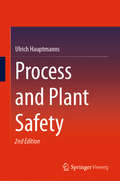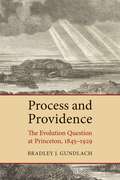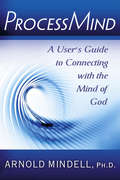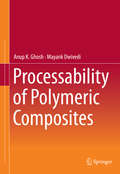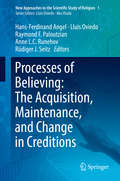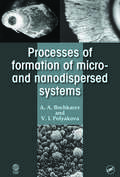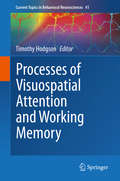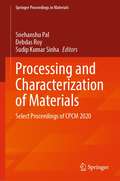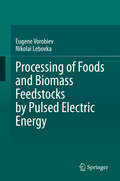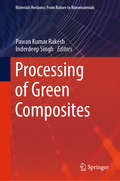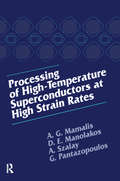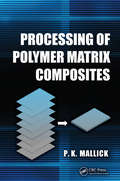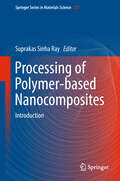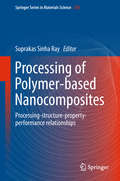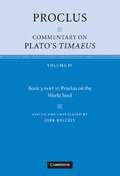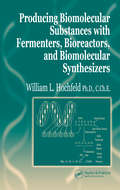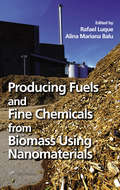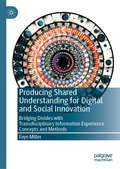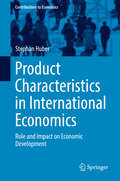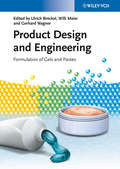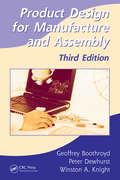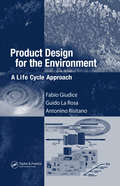- Table View
- List View
Process and Plant Safety
by Ulrich HauptmannsAccidents in industrial installations are random events. Hence they cannot be totally avoided. Only the probability of their occurrence may be reduced and their consequences be mitigated. The book proceeds from hazards caused by materials and process conditions to indicating engineered and organizational measures for achieving the objectives of reduction and mitigation. Qualitative methods for identifying weaknesses of design and increasing safety as well as models for assessing accident consequences are presented. The quantitative assessment of the effectiveness of safety measures is explained. The treatment of uncertainties plays a role there. They stem from the random character of the accident and from lacks of knowledge of some of the phenomena to be addressed. The reader is acquainted with the simulation of accidents, with safety and risk analyses and learns how to judge the potential and limitations of mathematical modelling. Risk analysis is applied amongst others to “functional safety” and the determination of “appropriate distances” between industry and residential areas (land-use planning). This shows how it can be used as a basis for safety-relevant decisions. Numerous worked-out examples and case studies addressing real plants and situations deepen the understanding of the subjects treated and support self-study.
Process and Providence: The Evolution Question at Princeton, 1845-1929
by Bradley J. GundlachCharles Hodge, James McCosh, B. B. Warfield -- these leading professors at Princeton College and Seminary in the nineteenth and early twentieth centuries are famous for their orthodox Protestant positions on the doctrine of evolution. In this book Bradley Gundlach explores the surprisingly positive embrace of developmental views by the whole community of thinkers at old Princeton, showing how they embraced the development not only of the cosmos and life-forms but also of Scripture and the history of doctrine, even as they defended their historic Christian creed.Decrying an intellectual world gone “evolution-mad,” the old Princetonians nevertheless welcomed evolution “properly limited and explained.” Rejecting historicism and Darwinism, they affirmed developmentalism and certain non-Darwinian evolutionary theories, finding process over time through the agency of second causes — God’s providential rule in the world -- both enlightening and polemically useful. They also took care to identify the pernicious causes and effects of antisupernatural evolutionisms. By the 1920s their nuanced distinctions, together with their advocacy of both biblical inerrancy and modern science, were overwhelmed by the brewing fundamentalist controversy.From the first American review of the pre-Darwinian Vestiges of the Natural History of Creation to the Scopes Trial and the forced reorganization of Princeton Seminary in 1929, Process and Providence reliably portrays the preeminent conservative Protestants in America as they defined, contested, and answered -- precisely and incisively -- the many facets of the evolution question.
ProcessMind
by Arnold MindellEinstein said, "I want to know the mind of God, the rest are details." This book is therapist Arnold Mindell's response. By processmind he means an earth-based experience of the universal state of consciousness that, he argues, pervades all reality. It is perhaps our most basic, least known, and greatest power, combining the nonlocality of modern physics with altered states of consciousness found in peak experiences. What makes this book unique is that it offers some experience of this mind-state to the reader. Mindell does so by connecting cosmic patterns seen in physics with experiences occurring in psychology and world spiritual traditions. He draws together ideas about Aboriginal totem spirits, quantum entanglement, and nonlocality to describe the "structure of God experiences." Enhancing his clear presentation are around 80 illustrations and 30 experiential exercises based on tested approaches that actualize our deepest, unitive consciousness. Through rational thinking and earth-based, inner experience, the reader can sense how the processmind's self-organizing intelligence helps with dreams, body symptoms, relationships, and large-group conflict issues. Altogether, the book is a kind of user's guide to tapping into an immense power that can benefit our own individual life and, ultimately, the world.
Processability of Polymeric Composites
by Anup K. Ghosh Mayank DwivediThis textbook covers the processing of advanced composites and their various technologies, with special emphasis on the distinct characteristics of processability. The book covers the impact of different processing techniques on the performance and characteristics of the final product. Written with a didactic approach, the volume contains extensive illustrations and pedagogic features (including examples and exercises) to help the reader assess and correlate existing technologies. The book will be useful as a text in graduate courses in processing of polymers and composites and can additionally be used as a professional reference.
Processes of Believing: The Acquisition, Maintenance, and Change in Creditions
by Raymond F. Paloutzian Lluis Oviedo Anne L.C. Runehov Hans-Ferdinand Angel Rüdiger J. SeitzThis volume answers the question: Why do we believe what we believe? It examines current research on the concept of beliefs, and the development in our understanding of the process of believing. It takes into account empirical findings in the field of neuroscience regarding the processes that underlie beliefs, and discusses the notion that beyond the interactive exploratory analysis of sensory information from the complex outside world, humans engage in an evaluative analysis by which they attribute personal meaning and relevance to the probabilistic representations of objects and events. Beliefs exert a strong influence on behaviour, decision-making, and identifying and solving problems. Despite their importance, beliefs have until recently not been at the centre of scientific interest. In fact, "belief" is an ill-defined phenomenon. From a transdisciplinary perspective the actual approaches to understanding belief seem incompatible as they attempt to highlight such different topics as "belief - religion", "belief - spirituality", "belief - faith", "belief - knowledge", "belief - attitude", "belief - disbelief", "belief - illusion", and "believing - brain function". This situation contradicts the idea that belief is close to pathological phenomena and that it should be eliminated from scientific discussions. Rather, believing is fundamental for understanding the many problems of every-day life. In fact, the book shows that beliefs are relevant for politics, international affairs, economy, law, or religions also in modern societies. This book presents the increasing scientific interest in beliefs and believing, and reflects the change in focus from the content aspect of belief towards the fluid nature of believing.
Processes of Formation of Micro -and Nanodispersed Systems
by A. A. Bochkarev V. I. PolyakovaProcesses of Formation of Micro- and Nanodispersed Systems is a comprehensive analysis and presentation of the physical processes and phenomena that lead to the formation of disperse materials. It also details the properties of disperse materials yielded from various processes.Special attention is given to the homogeneous condensation of metal vapo
Processes of Visuospatial Attention and Working Memory (Current Topics in Behavioral Neurosciences #41)
by Timothy HodgsonThis volume covers a broad range of current research topics addressing the function of visuospatial attention and working memory. It discusses a variety of perspectives ranging from evolutionary and genetic underpinnings to neural substrates/computational processes and the connection between attention and working memory. Contributions address the topic at the molecular, system and evolutionary scales and will be of interest to a range of audiences from animal behaviour specialists, experimental psychologists to clinicians in the field of psychiatry and neurology.
Processing and Characterization of Materials: Select Proceedings of CPCM 2020 (Springer Proceedings in Materials #13)
by Snehanshu Pal Debdas Roy Sudip Kumar SinhaThis book includes selected conference proceedings of Conference on Processing and Characterization of Materials (CPCM-2020). The content of the book includes processing of and characterization of materials, sustainable energy materials, defense materials, functionally graded materials, and composites which has significant impact on cutting-edge applications. The book also includes surface engineering, computational methods and materials, waste utilization, and corrosion and environmental degradation of materials. Design, research, and development studies, experimental investigations, theoretical analysis, and fabrication techniques relevant to the application of materials in various assemblies, ranging from individual components to complete structure are presented in the book. The book is useful for graduate students, researchers, and industry professionals alike.
Processing of Foods and Biomass Feedstocks by Pulsed Electric Energy
by Eugene Vorobiev Nikolai LebovkaThis book presents a comprehensive range of research on pulsed electric energy used in food processing, including sections on the fundamentals of electroporation and important techniques for the estimation of electroporation effects in various foods and biomass feedstocks. By focusing on application over theory, this book presents researchers with practical steps for processing techniques such as solid-liquid extraction, pressing, osmotic dehydration, drying, freezing and cooking. Special interest is given to the selective recovery and extraction of sugar, inulin, starch, proteins, polysaccharides, polyphenols, pigments, flavor compounds, phytochemicals and other of high-value components from food biomasses such as fruits and vegetables, leaves, herbs, mushrooms, microalgae and suspensions of cells. Processing of Foods and Biomass Feedstocks by Pulsed Electric Energy presents a singular overview of the biorefinery applications of pulsed electric energy for the processing of wastes and non-food biomasses such as root and tuber crops, grape waste, lignocellulosic biomass, oil crops and residues and seeds and peels of exotic and citrus fruits. The book begins by presenting general information on the fundamentals of electroporation and information on the procedures and protocols involved. Further chapters focus on the specific food processing operations involved and biorefinery applications for the processing of wastes and non-food biomasses. All of the relevant and up-to-date information any researcher needs on pulsed electric energy in food processing is presented here in this text.
Processing of Green Composites (Materials Horizons: From Nature to Nanomaterials)
by Inderdeep Singh Pawan Kumar RakeshThis book is a collection of chapters focusing on green composite materials. The selection of natural fibers and polymer matrix materials, and the bonding between them forms an essential aspect of this book. The book discusses the chemical treatment of natural fibers and their compatibility with different matrix materials. The growing applications of composites in every day life ranging from automobiles to aerospace are also discussed. The book highlights the importance of processing of natural fiber reinforced composite materials to enhance their mechanical strength and performance. The contents of this book will be beneficial for students, researchers and industry professionals working on composite materials.
Processing of High-Temperature Superconductors at High Strain
by A.G. MamalisThe discovery of high-temperature superconductivity [1986] by Bendnorz and Muller in the La-BA-Cu-O system resulted in very extensive research work about the discovery and synthesis of other high-temperature superconductors, such as Y-BA-Cu-O and Bi-Sr-Ca-Cu-O. These new superconducting materials, possessing superconductivity above liquid nitrogen
Processing of Polymer Matrix Composites: Processing and Applications
by P. K. Mallick<p>Polymer matrix composites are finding increasing number of applications due to their high weight-saving potential as well as unique characteristics, such as high strength-to-density ratio, fatigue resistance, high damping factor, and freedom from corrosion. While many textbooks are available on the mechanics of polymer matrix composites, few cover their processing. Processing of Polymer Matrix Composites fills this gap. The book focuses on the major manufacturing processes used for polymer matrix composites and describes process details, process parameters and their effects on properties and process-induced defects, and analytical and experimental methods used for understanding process conditions. <p>The book describes fibers, thermosetting and thermoplastic polymers, and interface characteristics that are important from the standpoint of both design and processing. It also emphasizes the applications of process fundamentals for both continuous fiber and short fiber polymer matrix composites. In addition the book considers quality inspection methods, tooling, and manufacturing costs and environmental and safety issues.
Processing of Polymer-based Nanocomposites: Introduction (Springer Series in Materials Science #277)
by Suprakas Sinha RayProcessing of polymer nanocomposites usually requires special attention since the resultant structure—micro- and nano-level, is directly influenced by among other factors, polymer/nano-additive chemistry and the processing strategy. This book consolidates knowledge, from fundamental to product development, on polymer nanocomposites processing with special emphasis on the processing-structure-property-performance relationships in a wide range of polymer nanocomposites. Furthermore, this book focuses on emerging processing technologies such as electrospinning, which has very exciting applications ranging from medical to filtration. Additionally, the important role played by the nanoparticles in polymer blends structures has been illustrated in the current book, with special focus on fundamental aspects and properties of nanoparticles migration and interface crossing in immiscible polymer blend nanocomposites.This book introduces readers to nanomaterials and polymer nanocomposites processing. After defining nanoparticles and polymer nanocomposites and discussing environmental aspects, the second chapter focuses on the synthesis and functionalization of nanomaterials with applications in polymers. A brief overview on nanoclay and nanoclay-containing polymer nanocomposites is provided in third chapter. The fourth chapter provides an overview of the polymer nanocomposites structural elucidation techniques, such as X-ray diffraction and scattering, microscopy and spectroscopy, rheology. The fifth chapter is dedicated to the polymer nanocomposites processing technologies, among which electrospinning, which has very exciting applications ranging from medical to filtration. The last chapter provides an overview on how melt-processing strategy impact structure and mechanical properties of polymer nanocomposites by taking polypropylene-clay nanocomposite as a model system. The book is useful to undergraduate and postgraduate students (polymer engineering, materials science & engineering, chemical & process engineering), as well as research & development personnel, engineers, and material scientists.
Processing of Polymer-based Nanocomposites: Processing-structure-property-performance relationships (Springer Series in Materials Science #278)
by Suprakas Sinha RayProcessing of polymer nanocomposites usually requires special attention since the resultant structure—micro- and nano-level, is directly influenced by among other factors, polymer/nano-additive chemistry and the processing strategy. This book consolidates knowledge, from fundamental to product development, on polymer nanocomposites processing with special emphasis on the processing-structure-property-performance relationships in a wide range of polymer nanocomposites. Furthermore, this book focuses on emerging processing technologies such as electrospinning, which has very exciting applications ranging from medical to filtration. Additionally, the important role played by the nanoparticles in polymer blends structures has been illustrated in the current book, with special focus on fundamental aspects and properties of nanoparticles migration and interface crossing in immiscible polymer blend nanocomposites.This book focuses heavily on the processing technologies and strategies and extensively addresses the processing-structure-property-performance relationships in a wide range of polymer nanocomposites, such as commodity polymers (chapter 1), engineering polymers (chapter 2), elastomers (chapter 3), thermosets (chapter 4), biopolymers (chapter 5), polymer blends (chapter 6), and electrospun polymer (chapter 7). The important role played by nanoparticles in polymer blends structures in particular is illustrated.The book is useful to undergraduate and postgraduate students (polymer engineering, materials science & engineering, chemical & process engineering), as well as research & development personnel, engineers, and material scientists.
Processing of RNA (CRC Press Revivals)
by David ApirionIn a fast-moving field it is unlikely that articles written more than a year ago would be completely up to date. The purpose of this book is to bring to the nonspecialist an overall view as well as an update on the state of the art as it existed in the beginning of 1982, and to the specialist the opportunity to have a single source of information for how the other organisms do it, and also to enable him to find out the status of the various aspects of RNA processing with which he might not be to familiar. even if only some of these goals are achieved, all those who labored so diligently to bring about the publication of this book would be more than gratified.
Processmind
by Arnold MindellEinstein said, "I want to know the mind of God, the rest are details." This book is therapist Arnold Mindell's response. By processmind he means an earth-based experience of the universal state of consciousness that, he argues, pervades all reality. It is perhaps our most basic, least known, and greatest power, combining the nonlocality of modern physics with altered states of consciousness found in peak experiences. What makes this book unique is that it offers some experience of this mind-state to the reader. Mindell does so by connecting cosmic patterns seen in physics with experiences occurring in psychology and world spiritual traditions. He draws together ideas about Aboriginal totem spirits, quantum entanglement, and nonlocality to describe the "structure of God experiences." Enhancing his clear presentation are around 80 illustrations and 30 experiential exercises based on tested approaches that actualize our deepest, unitive consciousness. Through rational thinking and earth-based, inner experience, the reader can sense how the processmind's self-organizing intelligence helps with dreams, body symptoms, relationships, and large-group conflict issues. Altogether, the book is a kind of user's guide to tapping into an immense power that can benefit our own individual life and, ultimately, the world.
Proclus: Volume 4, Book 3, Part 2, Proclus on the World Soul
by Dirk Baltzly ProclusIn the present volume Proclus describes the 'creation' of the soul that animates the entire universe. This is not a literal creation, for Proclus argues that Plato means only to convey the eternal dependence of the World Soul upon higher causes. In his exegesis of Plato's text, Proclus addresses a range of issues in Pythagorean harmonic theory, as well as questions about the way in which the World Soul knows both forms and the visible reality that comprises its body. This part of Proclus' Commentary is particularly responsive to the interpretive tradition that precedes it. As a result, this volume is especially significant for the study of the Platonic tradition from the earliest commentators onwards.
Produced Water
by Jerry Neff Kenneth LeeA state-of-the-art review of scientific knowledge on the environmental risk of ocean discharge of produced water and advances in mitigation technologies. In offshore oil and gas operations, produced water (the water produced with oil or gas from a well) accounts for the largest waste stream (in terms of volume discharged). Its discharge is continuous during oil and gas production and typically increases in volume over the lifetime of an offshore production platform. Produced water discharge as waste into the ocean has become an environmental concern because of its potential contaminant content. Environmental risk assessments of ocean discharge of produced water have yielded different results. For example, several laboratory and field studies have shown that significant acute toxic effects cannot be detected beyond the "point of discharge" due to rapid dilution in the receiving waters. However, there is some preliminary evidence of chronic sub-lethal impacts in biota associated with the discharge of produced water from oil and gas fields within the North Sea. As the composition and concentration of potential produced water contaminants may vary from one geologic formation to another, this conference also highlights the results of recent studies in Atlantic Canada.
Producing Biomolecular Substances with Fermenters, Bioreactors, and Biomolecular Synthesizers
by William L. HochfeldContaining authoritative and in-depth coverage, Producing Biomolecular Materials Using Fermenters, Bioreactors, and Biomolecular Synthesizers examines the bioproduction systems that support the controlled, automated, and quantity growth of proteins. The book discusses the substance, character, makeup, and quality of the basic materials used
Producing Fuels and Fine Chemicals from Biomass Using Nanomaterials
by Rafael Luque Alina Mariana BaluScarcity of resources and increasing population and energy demands are important issues of the twenty-first century. A multidisciplinary approach is needed to produce suitable alternatives-such as renewable resources-for a more sustainable future. One of the most promising and widely available renewable feedstocks is biomass, which has significant
Producing Shared Understanding for Digital and Social Innovation: Bridging Divides with Transdisciplinary Information Experience Concepts and Methods
by Faye MillerIn the Anthropocene age there is a need for unifying the relationships between people, planet and technology, their interactions, experiences and impacts across ecosystems. In response to this need, this book introduces unifying bridging concepts informational waves and transdisciplinary resonance towards producing shared understanding. This book also presents emerging methods for transdisciplinary projects focusing on moments, paradoxes and dialogues for digital social innovation and sustainable development partnership goals for improving quality of life. Shared understanding is about how people from different fields and perspectives are communicating, curating, embodying, intuiting and reflecting on shared responsibilities within social ecologies. As a guide to co-designing for information experiences that create meaningful moments of shared understanding, the author illuminates essential transferable, lateral mindsets and soft skills: knowing the gaps through imagination, creativity, listening and noticing, and bridging the gaps through problem emergence, multiple stakeholders, informed learning and personal change.
Product Characteristics in International Economics: Role And Impact On Economic Development (Contributions to Economics)
by Stephan HuberNational economies are linked through flows of capital and goods. This book addresses those linkages, analyzes their benefits for economic development, and evaluates a country’s opportunities to reap the best possible rewards by influencing the linkages. The book focuses on the role of product characteristics in international economics and their impact on economic development. After an introduction to the topic, it analyzes the influence of product sophistication on growth, and offers alternative means of measuring product characteristics. In turn, the book provides evidence for the impact of foreign equity on the characteristics of the products that firms produce. Moreover, it presents empirical findings that prove that the quality of a country's legal and institutional framework is influenced by said country’s predisposition to trade rule-of-law-intensive goods.
Product Design and Engineering
by Gerhard Wagner Ulrich Bröckel Willi MeierCovering the whole value chain - from product requirements and properties via process technologies and equipment to real-world applications - this reference represents a comprehensive overview of the topic. The editors and majority of the authors are members of the European Federation of Chemical Engineering, with backgrounds from academia as well as industry. Therefore, this multifaceted area is highlighted from different angles: essential physico-chemical background, latest measurement and prediction techniques, and numerous applications from cosmetic up to food industry.Recommended reading for process, pharma and chemical engineers, chemists in industry, and those working in the pharmaceutical, food, cosmetics, dyes and pigments industries.
Product Design for Manufacture and Assembly
by Geoffrey Boothroyd Peter Dewhurst Winston A. KnightHailed as a groundbreaking and important textbook upon its initial publication, the latest iteration of Product Design for Manufacture and Assembly does not rest on those laurels. In addition to the expected updating of data in all chapters, this third edition has been revised to provide a top-notch textbook for university-level courses in product
Product Design for the Environment: A Life Cycle Approach
by Antonino Risitano Fabio Giudice Guido La RosaIn recent years the increased awareness of environmental issues has led to the development of new approaches to product design, known as Design for Environment and Life Cycle Design. Although still considered emerging and in some cases radical, their principles will become, by necessity, the wave of the future in design. A thorough exploration of t
